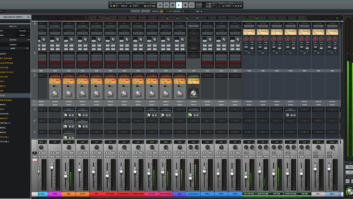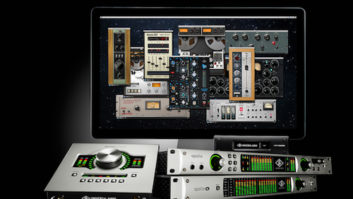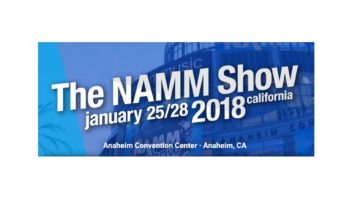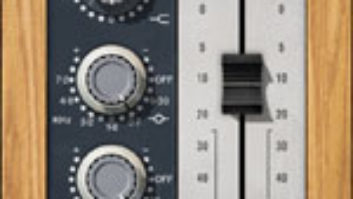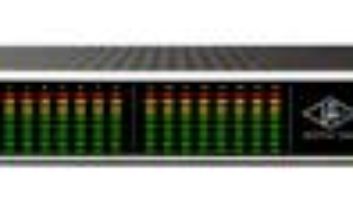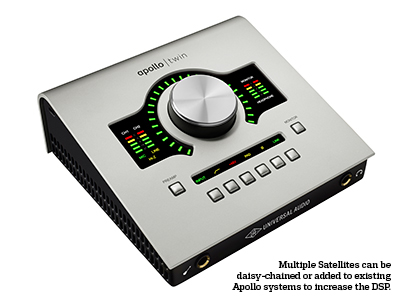
For the past year, I’ve been running into Apollos everywhere, and it seems like anyone who has heard UAD plug-ins immediately realizes that they can’t live without them and buys an Apollo or a UAD-2 system. Granted, there are plenty of other innovations coming from new-school plug-in manufacturers that do things that could never be accomplished by outboard gear. But when you instantiate a UAD processor, it’s like firing up the real thing. When using any classic hardware, I get this feeling like I’m harnessing the power of every great engineer and musician that has ever passed signal through that same circuit. The UAD plug-ins give me that same feeling.
If you have them, you want to use a lot of them, but there have always been a few key hang-ups and roadblocks. Unlike SSL, Universal Audio has never issued Native versions of its plug-ins; they only run on UAD-2 hardware. This means you have to buy UAD-2-friendly hardware and get it connected to your computer. But when you use up all of the chips in your UAD-2 hardware, it doesn’t matter how much CPU headroom you have left on your computer because you cannot insert any additional UAD-2 plug-ins. However, recent developments have helped to alleviate these concerns.
The issue has always been that UAD-2 processors are going to do a lot of math and try to turn it around fast enough so that latency is kept to a minimum. In order for that to be possible, data has to get to those chips through a high-bandwidth bus. PCIe is preferable, and while FireWire 800 has been deemed an acceptable solution, the low bandwidth relative to PCIe means that the FireWire Satellite introduces more latency than its PCIe equivalent. Also, Universal Audio offers a QUAD version of the UAD-2 Satellite DSP Accelerator.
For a while, the solution to this has been a Thunderbolt PCIe expansion chassis for UAD-2 cards, or a Thunderbolt expansion card for Apollo. The newest devices in the UAD-2 family, however, are Thunderbolt-ready powerhouses right out of the box.
On the Apollo side, there is the slick, compact Apollo Twin. This is a small, desktop interface with one or two SHARC processors. On the UAD-2 side, there is the new UAD-2 Satellite Thunderbolt, a low-profile, fan-free, Thunderbolt-connected box that can house your choice of one, two, four, or eight SHARC procoessors.
Apollo Twin DUO
The Apollo Twin features a stylish, well-built housing with a small footprint that doesn’t eat up too much space on a desktop. On the back panel, to the far right, is a pair of XLR/TRS combo jacks that can receive mic or line-level signals. To the left of those are four TRS outputs, two of which are designated “Monitor L and R.” The other pair is an additional set of line output jacks. These can be used to feed a mixdown deck, or would be useful in creating a hardware effects loop. On the far left of the back panel, there is a connector to attach the wall-wart power supply, and next to that, a power switch. Above these, you’ll find a Toslink connector that can accept eight channels of ADAT while also accommodating S/PDIF or S/MUX.
Next to the Toslink connector is a single Thunderbolt jack. The Thunderbolt situation is absolutely something to consider when contemplating the purchase of an Apollo Twin. For one, no Thunderbolt cable is included, so you will have to make that investment. But the bigger issue is that the Apollo Twin only has one Thunderbolt connector. If your machine only has one port, you will not be able to daisy-chain anything else to that connector. I have not yet seen a simple multi-port Thunderbolt hub, so you won’t be able to use an external display unless it is an Apple Thunderbolt Display that has two connectors. Fortunately, newer Macs have multiple Thunderbolt ports.
The top surface of the Apollo Twin slopes up from front to back, making it comfortable to view and reach the top panel controls when seated. At the center of the top panel is a very large knob attached to an endless rotary encoder. The knob feels well built. It doesn’t wiggle or tilt when turning. Overall it has a smooth, comfortable feel. The knob can be made to control the level of either of the two inputs, or it can be repurposed as a monitor level control. Buttons labeled “Preamp” and “Monitor” toggle the selection, while single-tapping “Monitor” repurposes the knob as a level control for the front panel headphone jack. Flanking the knob on either side are two pairs of five-segment LED meters displaying the input level of each channel on the left, and the level of whichever output signal is being controlled.
Tapping the Preamp button repeatedly toggles control of the two inputs, and the two inputs can be linked with a Link button. Controls for highpass filter, phantom power, pad and polarity flip are addressed by individual hardware buttons on the top panel. Switching between mic and line-level gain controls is accomplished by pressing the Input toggle control, but a connection present on the front panel instrument jack will override either selection and take over input Number One. Having dedicated buttons for all of this functionality means that it is rarely necessary to take trips to a software control panel. More and more, it seems that the alternative route is taken, but it just seems so much more efficient and ergonomic to have the buttons right there next to the level control.
Apollo Console
Building headphone mixes, including low-latency input signals, requires a trip to the software mixer. While many devices include a purely utilitarian mixer, with the sole purpose of blending low-latency inputs with software outputs, the Apollo Console sweetens the deal with a plethora of bells and whistles. The theoretical design of any software mixer is to replace the need for a small routing console in the control room. The Apollo Console gives you a full-on, large-format console with your choice of mic preamps, a variety of different routing buses, cue sends, effects sends and returns—any of which can be combined and sent to any of the hardware outputs. Its built-in DSP provides access to the entire fleet of UAD plug-ins for use in any part of a zero-latency mix.
You can use either of the Twin’s hardware inputs and run them through an entire channel strip of low-latency processing. In the first place, signal can run through a virtual mic preamp; currently, a Neve 1073 with EQ, a UA 610 with EQ, and an API Vision channel strip are available. The wildest part is that adjusting the preamp knobs within the plug-in actually sends the message back to the hardware, and adjusts the analog gain accordingly. Once the desired color is achieved, the signal can be dressed with a chain of up to four hardware inserts. Running through four plug-ins plus a virtual preamp without picking up any noticeable latency seems utterly impossible to me, but after hearing it, I can attest to the fact that Twin can absolutely pull it off.
I also assumed that only a stripped down set of plug-ins would be available, because there would be no way that some of the more complicated processors could turn around the math that quickly, but everything was there. Even with some heavy-hitters like an AMS reverb and an ENGL guitar amp and others all running in coincidence, the guitar pick called and the system responded in perfect sync.
Apollo Console’s potential applications span beyond studio recording, considering all of its available processing power and the fact that Apollo Console is a stand-alone application that doesn’t require a host DAW. Given its low latency, DJs and musicians could absolutely use Apollo Console as a live rig. Console configurations can be saved and any snapshot can be recalled with a click of the mouse, so having a hardware setup per song is totally feasible. Radio broadcasters and podcasters could also certainly benefit from using the software’s virtual preamps and processors in real time.
Field Test
When I first fired up the Twin, I spent a lot of time just listening to its D/A converters and getting familiar with them. I listened to a lot of music, and when I felt like I had a handle on the sound I mixed a trailer using the unit as my DAW back end, feeding my monitors. My initial impression was that it sounded extremely clean and clear. The bottom end was generous, respectably tight, and seemed honest. The midrange was incredibly open and detailed, and there was a great separation of the individual components in every mix I heard. The top end extended nicely, without being edgy or garbled in any way. The more I listened, the more I noticed that the upper midrange did seem slightly forward. It didn’t sound bad. In fact, it actually made everything sound a little clearer, even when listening at lower volumes, but that kind of dishonesty can sometimes lead to real troubles when mixing.
As I got into doing actual work with the Twin, I found myself in a situation with a lot of noisy production sound requiring treatment. When applying noise reduction, there is always a fine line between making it sound better and adding artifacts. The Twin’s circuitry was kind of like a magnifying glass, zeroing in on that area where the articulation of the dialog lives and where garbled digital artifacts are most noticeable. I was able to find that edge of reduction versus destruction with ease, and always stay on the safe side of it. Processing the dialog and keeping it ahead of the music bed also came very naturally when monitoring with the Twin’s outputs. When all was said and done, I took the mix around to the usual tour of iPhone, laptop, TV and other consumer speakers to check compatibility, and the mix translated incredibly well. Even in the worst-case scenarios, the dialog was clear and intelligible, and the music was not lost.
The Twin’s inputs have a sound that is similar to the outputs. I heard an especially wide dynamic range as the noise floor seemed very low. The detail and clarity of everything the Twin captured was impeccably preserved. The converters are really nice, and the preamp has incredible definition throughout the entire frequency spectrum, and imparts only the slightest color in the upper midrange. There is a little sparkle, but only in the best way possible.
Running the preamp through the 1073 preamp model was exciting. In contrast to the stock sound of the preamp, the 1073 model had that dark, warm, British character that Neve is known for. Shooting the UAD version against a hardware clone of that circuit was eerie: The sound was nearly identical. On a snare drum, both circuits presented the same warmth throughout the body of the snare. The top end, in both cases, cracked open into a pleasant, subtle, harmonic overdrive. A similar sound was present in a kick drum recording. The beater had a nice bristle that could cut through a mix, while the bottom was actually a bit fuller on the UAD version than the hardware.
Altogether, the Apollo Twin’s build, sound quality and overall operation are impressive. Once I installed the software, my computer recognized the unit every time it was attached. If there is anything to complain about, it would be the fact that we always just want more UAD plug-ins, and the two cores inside the Twin DUO are, at times, just not enough. With just the included DSP, the system maxed out at eight tracks of Studer A800. One EMT 140 eats up nearly 20 percent of the DSP. Putting a pair of 610s across the inputs takes about 30 percent of the DSP available. Granted, a healthy complement of 19 1176 Legacy compressors can run simultaneously. If you need more, however, Apollo Expanded has you in mind. Now, you can string together a number of UAD-2 Thunderbolt devices and aggregate their processing power. This is where the UAD-2 Satellite Thunderbolt comes to the rescue.
TRY THIS
When tracking guitars or re-amping them through miked amplifiers, sometimes multiple mics on one amp are required to get the right sound. Soloing each mic and placing it at the ideal position can lead to good individual sounds that combine into a comb-filtered mess. This problem can be eradicated before the 1s and 0s ever hit Pro Tools by using the UAD Little Labs IBP plug-in across the appropriate channel within the Apollo Console and sending the result to Pro Tools.
Product Summary
COMPANY: Universal Audio
PRODUCT: Apollo Twin DUO
WEBSITE:www.uaudio.com
PRICE: $899
PROS: Hardware buttons for controls. Well-built. Loaded with features.
CONS: Only connects with Thunderbolt. No second port to daisy chain.

Satellite Thunderbolt OCTO
The Satellite is a very attractive, extremely portable, sturdily built black box housing your choice of additional DSP for your system. It can run on its own, providing UAD-2 processing to your DAW. Multiple Satellite units can be attached, or you can pair the Satellite with an Apollo system to gain additional DSP.
The Satellite is not bus-powered and requires a provided external power supply, through a 4-pin XLR-type connector on the back panel. Other than that, the back panel features a rocker-style power switch and two Thunderbolt ports. I could attach the Satellite and then still connect an external display to my MacBook. Alternatively, I could daisy chain the Apollo Twin through the Satellite and combine the processing power of both units.
Installing the Satellite’s software was a bit of a process, but once it was done, as with the Twin, there were no issues of any kind. When I first started out, I was running UAD-2 Version 7, and the unit was recognized immediately whenever I would connect it. There were never any hang-ups or issues, the system ran flawlessly all of the time.
The UAD software displays a small usage meter that is small enough to stay open on a corner of the display. Three meters display available DSP, Program Memory and UAD RAM. As different processors use different amounts of each, one could max out before the others, so it is useful to monitor each factor. When attaching the Twin and the Satellite, the total resources available when combining the two were summed and displayed on these meters.
When it comes to the individual devices and their individual chips, opening the larger UAD Control Panel can provide more insight. Here, each hardware device is listed in a scrolling menu, and within each device the status of each core is displayed. The system does a round-robin allocation of processing, distributing little bits of work to each available chip. With eight cores to work with, I never came close to running out of DSP when doing music mixes. Considering that you could run 384 mono dbx 160s, or one EMT 250 takes up 1 percent of the total processing power, the sky is the limit. A full instance chart is available on Universal Audio’s Website: www.uaudio.com/support/uad/compatibility/instance-chart.html.
Via the plug-ins tab, additional UAD-2 plug-ins can be authorized or demoed. It’s almost too easy to start a demo and fall in love with a new must-have plug-in. Part if this ease is due to the fact that all of the UAD-2 plug-ins are installed in the initial setup, whether they are licensed or not. While this makes the addition of new plug-ins to your system a snap, it is a little awkward when accessing the plug-ins in a DAW. Whether you have a license for the processor or not, the lists in Pro Tools are exploding with options. I constantly find myself loading a plug-in only to find out that it is not authorized or that the demo is timed out. It’s a cruel tease. I suppose the solution is to simply buy them all.
The UAD-2 Satellite Thunderbolt OCTO is a no-brainer. Considering that the PCIe OCTO card is the same price, the fact that Universal Audio is essentially throwing in a Thunderbolt chassis with power supply for no extra charge makes the Satellite Thunderbolt a killer deal. If you’re adding on to an Apollo system, it seems like you can probably get away with just adding a QUAD, because I feel like six cores are plenty. That said, I was using it on music mixes with right around 30 tracks. If you do much larger mixes than that, you might need to go bigger. My only words of warning would be to proceed with caution. Every plug-in has a 14-day demo, and if you try one, you will almost certainly buy it.
TRY THIS
I really like the sound of the Thermionic Culture Vulture emulation from UAD. It’s great for warming and thickening a 2-bus or for mastering. Working with the Triode setting and the overdrive switches engaged, push the Drive until the track starts to distort. Then, tweak the Drive and Bias to the point where the track is crispy and buzzing, but there is still clear intelligibility to the key elements of the mix, like snare and vocals. Then take the mix control all the way down, and slowly sneak it back up until you hear the mix thicken up.
Product Summary
COMPANY: Universal Audio
PRODUCT: UAD Satellite Thunderbolt OCTO
WEBSITE:www.uaudio.com
PRICES: $1,499 with Analog Classics plug-in bundle; $5,999 with Ultimate 3 plug-in bundle.
PROS: Amazing-sounding plug-ins. A lot of DSP in a portable package.
CONS: None found
Brandon T. Hickey is an independent audio engineer and educator.
